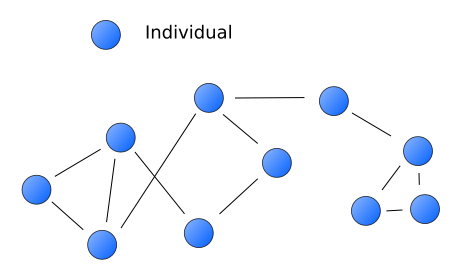|
Social Network (sociolinguistics)
In the field of sociolinguistics, social network describes the structure of a particular speech community. Social networks are composed of a "web of ties" (Lesley Milroy) between individuals, and the structure of a network will vary depending on the types of connections it is composed of. Social network theory (as used by sociolinguists) posits that social networks, and the interactions between members within the networks, are a driving force behind language change. Structure Participants The key participant in a social network is the ''anchor'', or center individual. From this anchor, ties of varying strengths radiate outwards to other people with whom the anchor is directly linked. These people are represented by ''points''. Participants in a network, regardless of their position, can also be referred to as ''actors ''or ''members''. Relationships There are multiple ways to describe the structure of a social network. Among them are ''density, member closeness centrality, ... [...More Info...] [...Related Items...] OR: [Wikipedia] [Google] [Baidu] |
Sociolinguistics
Sociolinguistics is the descriptive study of the effect of any or all aspects of society, including cultural norms, expectations, and context, on the way language is used, and society's effect on language. It can overlap with the sociology of language, which focuses on the effect of language on society. Sociolinguistics overlaps considerably with pragmatics and is closely related to linguistic anthropology. Sociolinguistics' historical interrelation with anthropology can be observed in studies of how language varieties differ between groups separated by social variables (e.g., ethnicity, religion, status, gender, level of education, age, etc.) and/or geographical barriers (a mountain range, a desert, a river, etc.). Such studies also examine how such differences in usage and differences in beliefs about usage produce and reflect social or socioeconomic classes. As the usage of a language varies from place to place, language usage also varies among social classes, and it is t ... [...More Info...] [...Related Items...] OR: [Wikipedia] [Google] [Baidu] |
African American Vernacular English
African-American Vernacular English (AAVE, ), also referred to as Black (Vernacular) English, Black English Vernacular, or occasionally Ebonics (a colloquial, controversial term), is the variety of English natively spoken, particularly in urban communities, by most working- and middle-class African Americans and some Black Canadians. Having its own unique grammatical, vocabulary, and accent features, AAVE is employed by middle-class Black Americans as the more informal and casual end of a sociolinguistic continuum. However, in formal speaking contexts, speakers tend to switch to more standard English grammar and vocabulary, usually while retaining elements of the nonstandard accent. Despite being widespread throughout the United States, AAVE should not be assumed to be the native dialect of all African Americans. As with most African-American English, African-American Vernacular English shares a large portion of its grammar and phonology with the rural dialects of the Southe ... [...More Info...] [...Related Items...] OR: [Wikipedia] [Google] [Baidu] |
